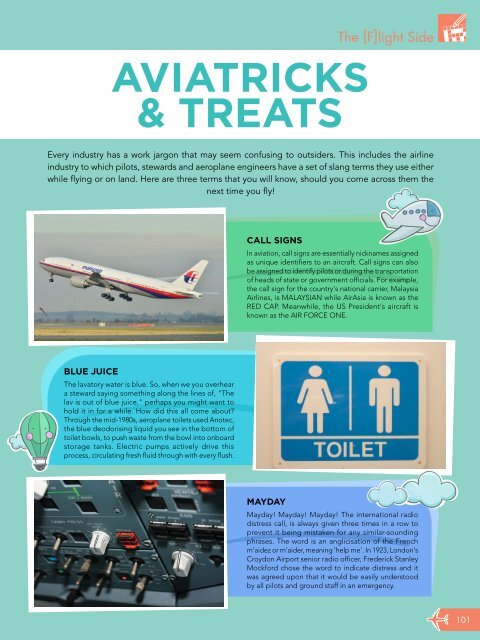Create successful ePaper yourself
Turn your PDF publications into a flip-book with our unique Google optimized e-Paper software.
Aviatricks<br />
& Treats<br />
The [F]light Side<br />
Every industry has a work jargon that may seem confusing to outsiders. This includes the airline<br />
industry to which pilots, stewards and aeroplane engineers have a set of slang terms they use either<br />
while flying or on land. Here are three terms that you will know, should you come across them the<br />
next time you fly!<br />
Call signs<br />
In aviation, call signs are essentially nicknames assigned<br />
as unique identifiers to an aircraft. Call signs can also<br />
be assigned to identify pilots or during the transportation<br />
of heads of state or government officials. For example,<br />
the call sign for the country's national carrier, Malaysia<br />
Airlines, is MALAYSIAN while AirAsia is known as the<br />
RED CAP. Meanwhile, the US President's aircraft is<br />
known as the AIR FORCE ONE.<br />
Blue Juice<br />
The lavatory water is blue. So, when we you overhear<br />
a steward saying something along the lines of, "The<br />
lav is out of blue juice," perhaps you might want to<br />
hold it in for a while. How did this all come about?<br />
Through the mid-1980s, aeroplane toilets used Anotec,<br />
the blue deodorising liquid you see in the bottom of<br />
toilet bowls, to push waste from the bowl into onboard<br />
storage tanks. Electric pumps actively drive this<br />
process, circulating fresh fluid through with every flush.<br />
Mayday<br />
Mayday! Mayday! Mayday! The international radio<br />
distress call, is always given three times in a row to<br />
prevent it being mistaken for any similar-sounding<br />
phrases. The word is an anglicisation of the French<br />
m’aidez or m’aider, meaning 'help me'. In 1923, London's<br />
Croydon Airport senior radio officer, Frederick Stanley<br />
Mockford chose the word to indicate distress and it<br />
was agreed upon that it would be easily understood<br />
by all pilots and ground staff in an emergency.<br />
101

















